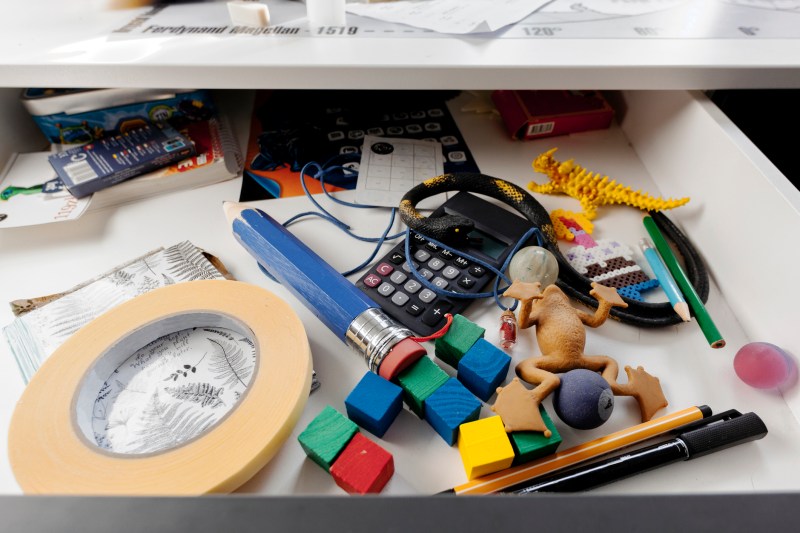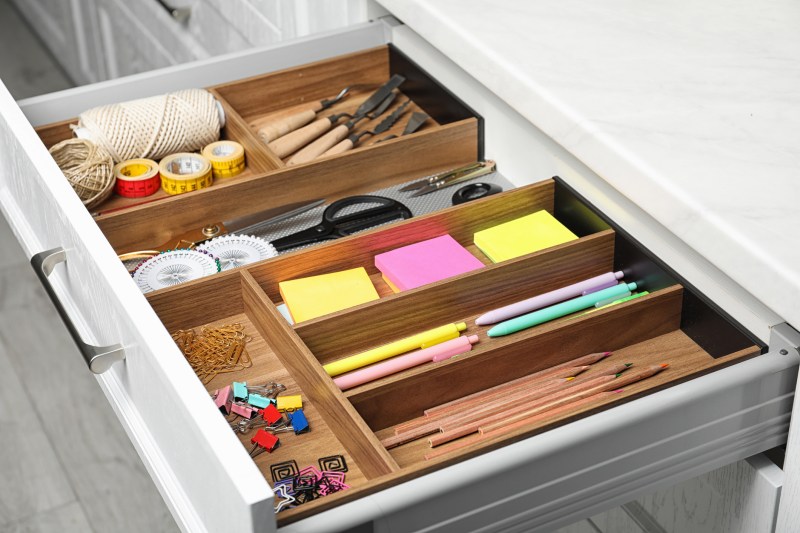Comedian Katt Williams has an old bit about every family having “a plastic bag full of plastic bags.” The joke is hilarious because it’s universally true, but most people can’t explain precisely why or how this plastic bag hoarding became an American habit.
The same can be said for the kitchen junk drawer. Every home has a designated drawer in the kitchen overflowing with pencils, random keys, board game pieces, rolls of tape, mini flashlights, clothespins, glue sticks, USB drives, highlighters, rubber bands, and toys that parents hope their kids forgot all about.
Every few months, organizing the junk drawer is a task that tops a person's daily to-do list. Especially when the drawer no longer shuts completely and the chaos inside starts nagging at your OCD tendencies.
Make your life easier by following these helpful suggestions for organizing your junk drawer and keeping it in order.
Take Everything Out of the Drawer
The first step to organizing a junk drawer is to take everything out of the drawer. Don’t try and organize the items just yet. Just take everything out of the drawer, dump it onto the kitchen counter, and clean out the drawer.
Grab some paper towels, a bottle of disinfectant, and maybe even the power washer if it’s been a while. Clean the drawer out thoroughly. You’re going to want to work with a clean slate, and the sudden barrenness of the drawer will cause you to really rethink what goes back inside.

Ditch Duplicates
Scan all of the junk on the counter and organize similar items together. Put all the rubber bands, paper clips, batteries, toothpicks, random keys, assorted Allen wrenches, and soon-to-expire coupons in a pile with their siblings. Now that all of the items are grouped together, assess the size of the stacks and ask yourself, “How often do I really use/need this item?”
How many free bank pens does one person need?! A few Post-it note pads are acceptable. Keeping around enough Post-its to write a note a day for a decade is excessive. If you rarely use paper clips but own enough to link them all into a protective vest, throw some away. If you really need to buy more down the road, you can afford a new box.
Hey, sweet calculator! Is it better than the one on your phone? Will one pair of scissors handle all your cutting needs, or do you plan on cosplaying Edward Scissorhands this Halloween?
One or two of each item is more than enough.
Toss It If You Don't Know Its Purpose
People have this fantasy that they’ll save the day because they managed to hang onto a random clip, cord, or key. Alright, time for a cold splash of reality. All those random cords, specific tools that come with furniture, keys, buttons, and other items you’ve been hoarding for the day you might need them? Well, here’s a fun fact — YOU WON’T NEED THEM! If you haven’t needed the item by now, you’re never going to need it.
Another clue that you’ll never need an item again is if you don’t even know how it came into your possession in the first place. Where did you get a keychain for the Hoover Dam? Have you ever been to the Hoover Dam? You shouldn’t own more keychains than keys.
Just toss it in the trash.
Put Stuff in the Correct Places
In the middle of organizing your junk drawer, you’ll come to a stunning realization about yourself and your family — you’re all incredibly lazy. You’ll come across loose change and wonder, “Why isn’t this in the change jar?” You’ll collect a deck of cards or two and wonder, “Why aren’t these with the rest of the games?” “Why is my tape measure not in the toolbox with the rest of the tools,” you’ll ponder aloud.
The same organizational questions will arise when you come across a single crayon, a pair of sunglasses, and a child-sized face mask. There’s a strong chance that most of the items in your junk drawer are just stray items that belong somewhere else. You were too lazy to put those items in the correct spot, so you shoved them in the drawer.
Start putting stuff back where it belongs, and you won’t have to organize your junk drawer every six months! Duh.

Buy Organizers
Now that you’ve played Survivor with all of the crap in your junk drawer, it’s time to organize the contents. Amazon and Walmart sell countless drawer organizing options, but if you want to reorganize on the cheap, use small boxes or even plastic food containers. Plastic sandwich bags are another option, especially for items like batteries, paper clips, and rubber bands.
Don’t spend a ton of money to keep random junk organized in a drawer people rarely go into.
Be Vigilant
Now that you’ve organized the kitchen drawer, tossed out all duplicate items, ditched stuff that never served a purpose, and disposed of all the useless junk cluttering your life, it’s time to talk about upkeep.
Take a mental snapshot of how good the drawer looks — everything in its proper place and all of the items at the ready to solve specific problems. Make a concerted effort to keep the drawer as minimalistic and systemized as possible. Before shoving any item in the drawer, ask yourself, “Will I ever really need this item again?” Be honest with yourself, and DON’T save items just to save them.
Now, about that garage.




